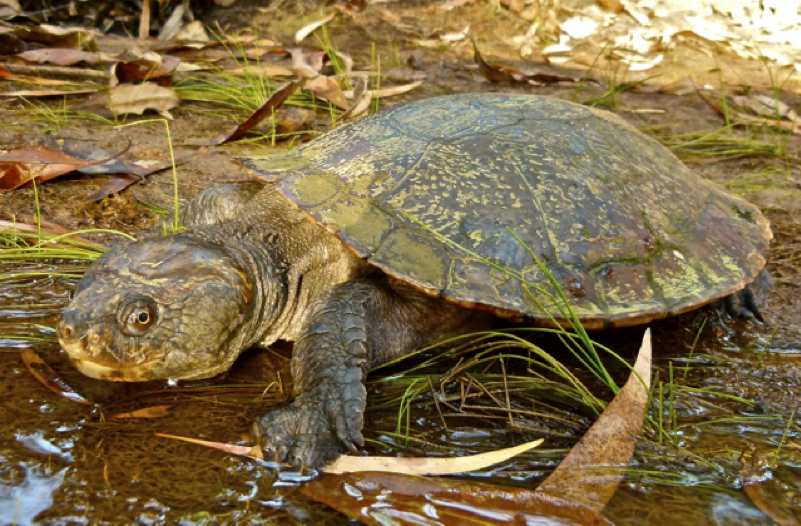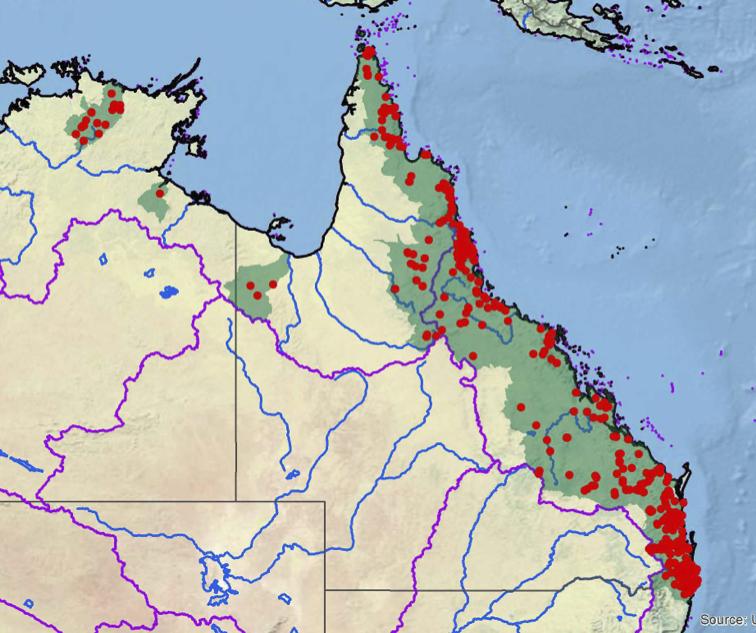Myuchelys latisternum, 073
Myuchelys latisternum (Gray 1867) –
Sawshelled Turtle, Saw-Shell Turtle
Alastair Freeman1 and John Cann2
1Threatened Species Branch, Environment and Heritage Protection,
P.O. Box 975, Atherton, Queensland 4883 Australia [[email protected]];
226 Yarra Road, Phillip Bay, New South Wales 2036 Australia [[email protected]]
Summary. – The Sawshelled Turtle, Myuchelys latisternum (Family Chelidae), is a small to medium-sized short-necked turtle (maximum recorded carapace length to 287 mm in females, 224 mm in males) endemic to northern and eastern Australia. Historically known for a long time as Elseya latisternum, the species has recently also been occasionally associated with the invalid genus name Wollumbinia. The species inhabits deep to shallow pools and lagoons on permanently flowing waterways, particularly in the upper reaches and side channels of larger rivers. Myuchelys latisternum is chiefly carnivorous, feeding on a variety of aquatic invertebrates, but will also consume fruit, and other vegetation. Nests are laid in fine sand or alluvial substrate on banks close to the water, with clutch size ranging from 9 to 20 eggs and oviposition recorded from September to March. The species is widespread and no significant current conservation threats have been identified.
Distribution. – Australia. The species has a broad distribution from the Richmond River in northern New South Wales north along the east coast of Queensland to the Jardine River at the tip of Cape York, around the rivers draining into the Gulf of Carpentaria to the headwaters of the Daly River in the Northern Territory. Occupies streams of the Arnhem Land Plateau and associated escarpment plunge pools, including those of the Liverpool, Katherine, South Alligator and Mary Rivers.
Synonymy. – Elseya latisternum Gray 1867, Emydura latisternum, Elseya latisternum latisternum, Wollumbinia latisternum, Myuchelys latisternum, Euchelymys spinosa Gray 1871a, Elseya latisternon Gray 1871b (nomen novum), Wollumbinia dorsii Wells 2009 (nomen illegitimum).
Subspecies. – None currently known.
Status. – IUCN 2013 Red List: Not Listed (Least Concern, LC, assessed 1996), TFTSG Draft Red List: Least Concern (LC, assessed 2011); CITES: Not Listed; Australia: protected under the Territory Parks and Wildlife Conservation Act 1998, the National Parks and Wildlife Act 1979 in New South Wales, and the Queensland Nature Conservation Act 1992. International trade in this species is limited by strict control of live exports from Australia under the Environment Protection and Biodiversity Conservation Act 1999.
Citation:
Freeman, A. and Cann, J. 2014. Myuchelys latisternum (Gray 1867) – Sawshelled Turtle, Saw-Shell Turtle. In: Rhodin, A.G.J., Pritchard, P.C.H., van Dijk, P.P., Saumure, R.A., Buhlmann, K.A., Iverson, J.B., and Mittermeier, R.A. (Eds.). Conservation Biology of Freshwater Turtles and Tortoises: A Compilation Project of the IUCN/SSC Tortoise and Freshwater Turtle Specialist Group. Chelonian Research Monographs No. 5, pp. 073.1–8, doi:10.3854/crm.5.073.latisternum.v1.2014, //iucn-tftsg.org/cbftt/.
(Adobe Acrobat 6.0 or later required)

Adult female Myuchelys latisternum, Chillagoe Creek, far northern Queensland.
Photo by Alastair Freeman.
Distribution:

Distribution of Myuchelys latisternum in Australia. Purple lines = boundaries delimiting major watersheds (level 3 hydrologic unit compartments – HUCs); red dots = museum and literature occurrence records of native populations based on Iverson (1992), plus more recent and authors’ data; green shading = projected native distribution based on GIS-defined HUCs constructed around verified localities and then adding HUCs that connect known point localities in the same watershed or physiographic region, and similar habitats and elevations as verified HUCs (Buhlmann et al. 2009), and adjusted based on authors’ and others’ subsequent data. Data used in the creation of this map has been collected by a variety of scientists, naturalists and land managers from a range of institutions and government departments. Distribution of Myuchelys latisternum for Queensland based on records compiled from the Queensland government’s Wildnet database. Distribution of Myuchelys latisternum for Northern Territory and New South Wales compiled from the Australian government’s Atlas of Living Australia (part of the Global Biodiversity Information Facility). Authors’ datasets make up part of these databases; additional data provided by A. Georges of the Australian Ecology Research Group, University of Canberra.








